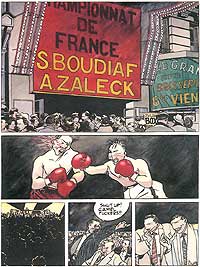
|
It tells the story of a Saïd Boudiaf, a gifted Algerian boxer whose career peaks during the late 1950s in Paris. Still a colony of France at the time, Algeria's National Liberation Front (FLN) had begun a series of bombings to oust the occupiers. Upon arriving at the Paris train station Boudiaf gets immediately harassed by gendarmes who suspect any Arab of being a terrorist. Desperately trying to stay neutral in an atmosphere that insists on polarization, he declares, "I'm on the side of boxing." But when he defeats the French champion the stadium erupts in a riot. As he rises to be European champ, things get hotter, especially when his brother joins the resistance and his girlfriend turns out to be an agent as well. The book culminates during the violently suppressed Paris protests of 1961.
But it all happens way too fast, with little subtlety or character development. Boudiaf's neutrality has no grounding and seems unlikely. The story gets so busy that the title, for example, remains a mystery. Boudiaf arrives in America for a page and a half and immediately returns to Paris having done little more than pose for pictures. Then just as suddenly, the books ends with a big, unsatisfying question mark. Even the boxing matches are reduced to little more than didactic description accompanied by snapshot-like panels. Unlike last year's masterful "Golem's Mighty Swing," (see the TIME.comix review), about a Jewish baseball team, one never feels the author has any great love or knowledge of the sport he portrays. Perhaps the world's oldest sports metaphor, boxing as a racial/political crucible has been done much better.

|
What "Road to America" excels at is atmosphere. Gorgeously printed in full color on large, nearly nine by twelve, heavy, off-white paper, it looks fantastic. Layers of translucent watercolor seem to have soaked into the paper, achieving one of the most varied and spectacular of palates I've seen in a comicbook. Typical of European comic-making Baru puts his stylized characters into carefully-detailed, realistic settings. While its setting becomes nostalgic, its sense of danger does not. Filled with paranoia, prejudice and terrorism, the time and place have a particular resonance now.
Like a quick three-rounder between a pair of pretty boys, Baru's "Road to America" is a little too short and a little too obvious, but it's still beautiful to look at.
